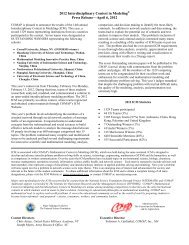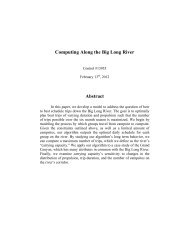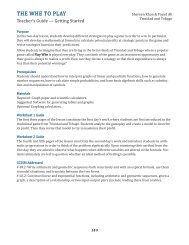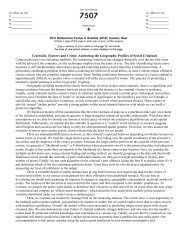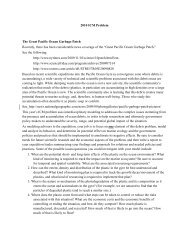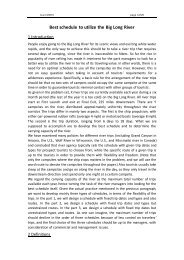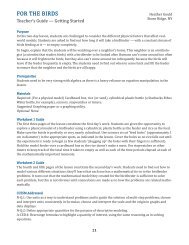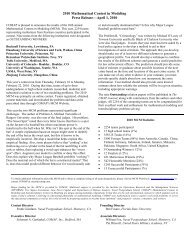Team 9159: Higher in the Air: Design of Snowboard Course
Team 9159: Higher in the Air: Design of Snowboard Course
Team 9159: Higher in the Air: Design of Snowboard Course
Create successful ePaper yourself
Turn your PDF publications into a flip-book with our unique Google optimized e-Paper software.
<strong>Team</strong> # <strong>9159</strong> page19 <strong>of</strong> 22<br />
6.1 Safety Analysis<br />
No one wants to get hurt <strong>in</strong> games. The safety requirements should always be<br />
put <strong>in</strong> <strong>the</strong> first place. Take <strong>the</strong> design <strong>of</strong> edge angle as an example. In <strong>the</strong>oretical<br />
halfpipe <strong>the</strong> slope angle near edges, named as θ e , should be close to 90 o . However,<br />
such large θ e means less hold<strong>in</strong>g force from halfpipe to player, which will <strong>in</strong>crease<br />
<strong>the</strong> possibility for player to fly away <strong>the</strong> track too early. At <strong>the</strong> same time, when<br />
<strong>the</strong> player falls onto <strong>the</strong> surface <strong>of</strong> <strong>the</strong> halfpipes edge from air, <strong>the</strong> shock is <strong>in</strong><br />
proportional to cos θ. So small θ e may <strong>in</strong>crease <strong>the</strong> shock, hurt<strong>in</strong>g players or mak<strong>in</strong>g<br />
<strong>the</strong>m lose <strong>the</strong>ir balance. In conclusion, θ e should nei<strong>the</strong>r be too large nor too small.<br />
Usually this is set from 83 o to 88 o [3].<br />
The slope angle <strong>of</strong> <strong>the</strong> halfpipe, ϕ, is ano<strong>the</strong>r factors related to safety. Larger<br />
ϕ means higher jump but also higher danger. Therefore, while adjust<strong>in</strong>g ϕ <strong>in</strong> our<br />
design, we could only slightly <strong>in</strong>crease it from <strong>the</strong> <strong>the</strong>oretical value 17.1 o to about<br />
17.5 o . This is also <strong>the</strong> actual slope angle used <strong>in</strong> regular game nowadays.<br />
Besides, to m<strong>in</strong>imize <strong>the</strong> energy loss caused by friction, <strong>the</strong> bottom part should<br />
be abandoned (<strong>in</strong> o<strong>the</strong>r words, a should equals w). However, we ma<strong>in</strong>ta<strong>in</strong> this part,<br />
to give <strong>the</strong> player more time to prepare <strong>the</strong> next jump.<br />
6.2 The Construction<br />
The shape <strong>of</strong> ellipse is not a big problem challenge <strong>in</strong> actual construction. The<br />
build<strong>in</strong>g <strong>of</strong> precipitous ramp may <strong>in</strong>crease <strong>the</strong> difficulty, s<strong>in</strong>ce <strong>the</strong> sharp cliff cannot<br />
hold <strong>the</strong> snow firmly on its surface. Therefore, decreas<strong>in</strong>g θ e from nearly 90 o to 85 o<br />
can also meet construction requirements.<br />
6.3 The Twist<br />
In regulation games, players are demanded to play more twists <strong>in</strong> <strong>the</strong> air. The<br />
angular velocity for twists is obta<strong>in</strong>ed by wriggle <strong>the</strong> waist and stomp <strong>the</strong> ramp.<br />
To help players perform more twists, we should provide <strong>the</strong>m more time <strong>in</strong> <strong>the</strong> air,<br />
and <strong>of</strong>fer <strong>the</strong>m a more safe side wall to step on. So on one hand, we could <strong>in</strong>crease<br />
ϕ to speed <strong>the</strong> player up with<strong>in</strong> <strong>the</strong> safe range. On <strong>the</strong> o<strong>the</strong>r hand, as mentioned<br />
above, <strong>the</strong> edge angle should be a little smaller than 90 o .<br />
19







